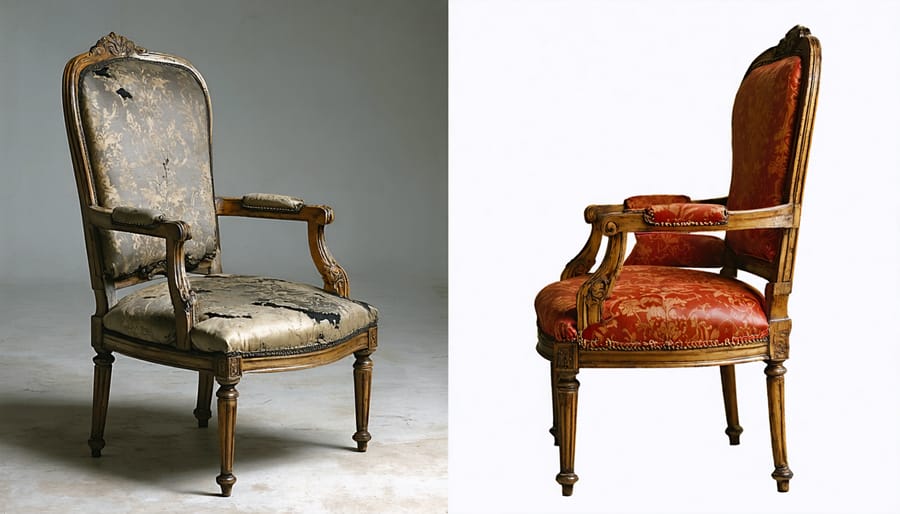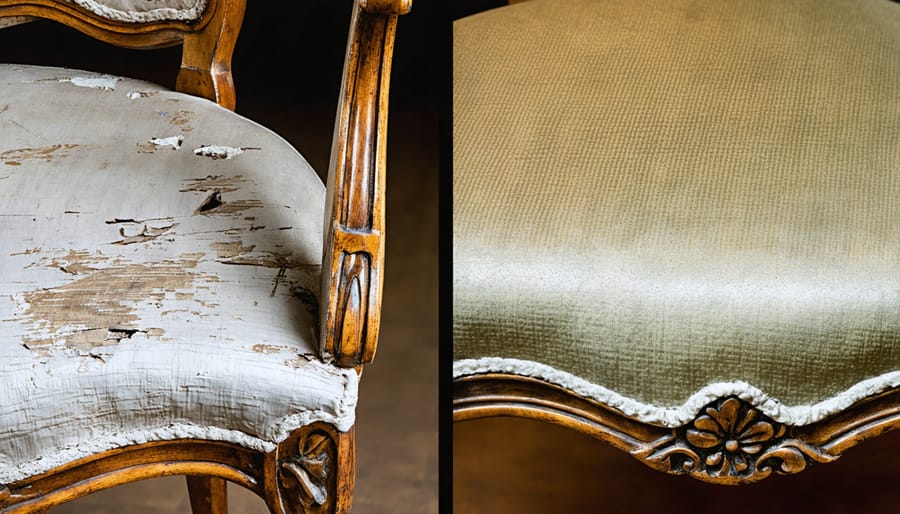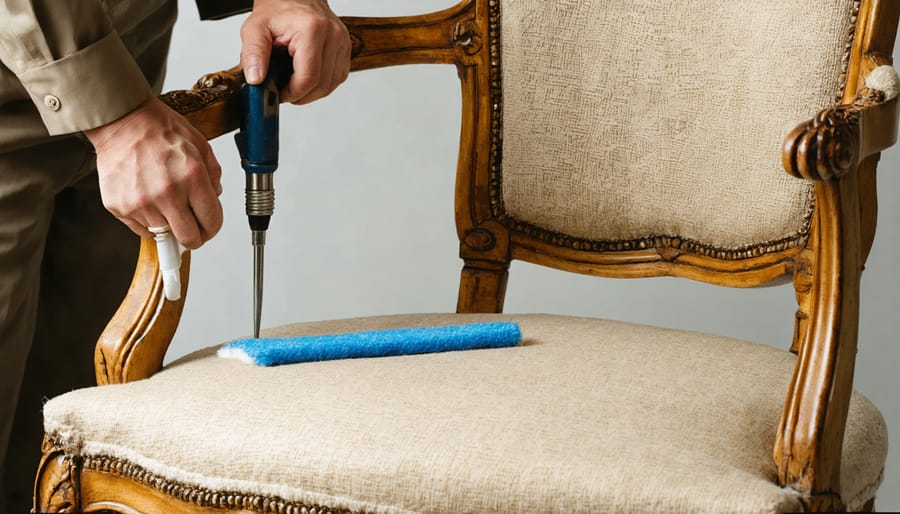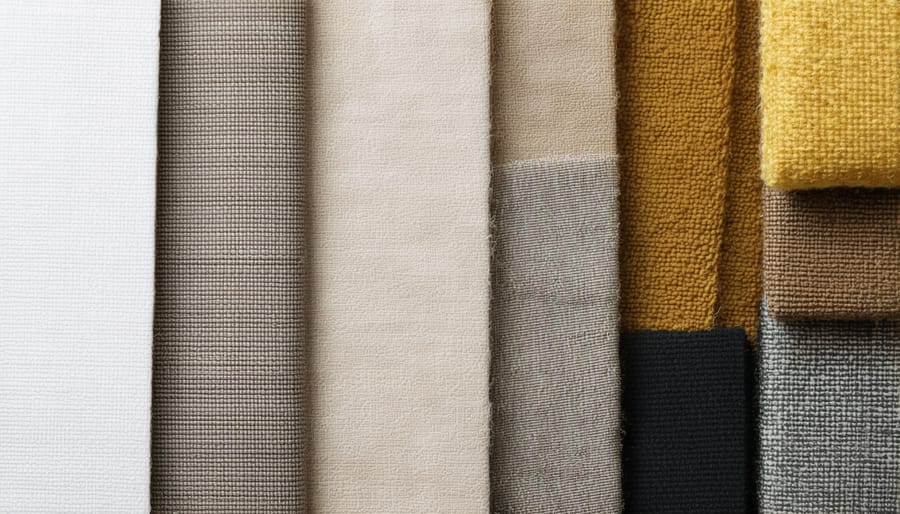
Preserving an antique chair’s upholstery requires meticulous attention to historical accuracy and craftsmanship excellence. Master upholsterers recognize these pieces as more than just furniture – they’re artifacts that tell stories of craftsmanship spanning centuries. From Victorian button-tufted parlor chairs to elegant Louis XV bergères, each antique presents unique challenges in material selection, structural integrity, and period-appropriate restoration techniques.
The art of antique chair upholstery demands a delicate balance between maintaining historical authenticity and ensuring practical usability. Professional restorers must consider original construction methods, historically accurate fabrics, and proper preservation techniques while adapting modern conservation standards to protect these treasured pieces for future generations.
Whether you’re a collector seeking to preserve a family heirloom or a restoration professional approaching a new project, understanding the fundamentals of antique upholstery is crucial. The right combination of traditional methods, appropriate materials, and contemporary conservation practices can breathe new life into these cherished pieces while preserving their historical significance and monetary value.
This comprehensive guide explores essential techniques, material considerations, and professional insights for successfully upholstering antique chairs while maintaining their integrity and value.
Antique chairs commonly face several upholstery-related challenges that develop over time. Fabric wear is perhaps the most visible issue, manifesting as fraying, fading, or tearing, particularly in areas of frequent contact like seat cushions and armrests. Sunlight exposure often accelerates this deterioration, causing once-vibrant fabrics to become brittle and discolored.
Stuffing deterioration presents another significant concern. Traditional materials like horsehair, cotton, or wool batting can compress, shift, or break down, resulting in uneven seating surfaces and reduced comfort. This issue frequently appears as sagging or lumpy areas in the seat and back cushions.
Spring damage poses a more structural challenge. Original springs may rust, lose tension, or break entirely, compromising the chair’s support system. You might notice this problem through uneven seating, squeaking sounds when sitting, or visible deformation in the chair’s profile. The webbing that supports these springs can also deteriorate, leading to additional structural instability.
Dry rot in padding materials and loosening of tacking points are other common issues that require attention, especially in chairs from humid environments or those exposed to temperature fluctuations.

Before beginning any restoration work, thorough documentation of your antique chair’s original condition, materials, and construction methods is essential. Start by photographing the piece from multiple angles, paying special attention to unique details, wear patterns, and existing upholstery techniques. Create detailed sketches or diagrams showing the layering of materials and note any manufacturer’s marks or stamps.
Keep a restoration journal documenting the chair’s current state, including fabric samples, thread colors, and padding materials. Research your chair’s era through furniture history books, museum archives, and antique dealer catalogs to ensure period-appropriate restoration choices. Many historical societies and furniture museums maintain databases of original upholstery patterns and techniques from different periods.
Consider consulting preservation specialists who can help identify authentic materials and methods used during your chair’s time period. They can often provide valuable insights into traditional techniques that will maintain the piece’s historical integrity. Document each step of the restoration process with photos and notes, creating a valuable reference for future maintenance or repairs while preserving the chair’s historical narrative.

Proper maintenance of your antique upholstered chair requires gentle, methodical care to preserve its historical value and structural integrity. Following expert antique furniture cleaning techniques is essential to prevent damage while keeping your piece beautiful.
Begin with regular dusting using a soft brush attachment on your vacuum cleaner, working at low power to avoid stressing delicate fabrics. Always vacuum in the direction of the nap to prevent fiber damage. For deeper cleaning, consider using safe cleaning solutions specifically formulated for antique fabrics.
Spot-clean stains immediately using a clean white cloth, blotting rather than rubbing to prevent fiber damage. Test any cleaning solution on an inconspicuous area first. Keep your chair away from direct sunlight and heat sources to prevent fabric fading and deterioration. Maintain consistent humidity levels (between 45-55%) to protect both the upholstery and wooden frame.
Inspect the chair quarterly for signs of wear, pest activity, or loose joints. Pay special attention to stress points where the fabric meets the frame. Consider using protective arm covers in high-wear areas while maintaining the chair’s aesthetic appeal. If you notice any significant issues, consult a professional restoration specialist immediately to prevent further damage.
For long-term preservation, schedule professional cleaning every 12-18 months, depending on usage. This helps maintain the fabric’s integrity while preserving the chair’s historical value for future generations.
Maintaining proper environmental conditions is crucial for preserving your antique upholstered chair’s integrity and extending its lifespan. The ideal temperature range should be kept between 65-75°F (18-24°C), with relative humidity levels maintained at 45-55%. These conditions help prevent material degradation and minimize the risk of mold growth or fabric deterioration.
Direct sunlight can be particularly damaging to antique upholstery, causing fading and weakening of fabrics. Position your chair away from windows or use UV-filtering window treatments. If natural light is unavoidable, consider using protective covers when the chair isn’t in use.
Climate control becomes especially important when considering seasonal care considerations, as extreme temperature and humidity fluctuations can stress the materials. During winter months, avoid placing antique chairs near heating vents or radiators, as the direct heat can dry out and damage both the upholstery and wooden components.
In spaces without climate control, consider using a dehumidifier during humid months and a humidifier during dry periods. Monitor the environment using a hygrometer to ensure conditions remain stable. For storage, choose a clean, dry space away from basement moisture or attic heat. Never store antique upholstered pieces in plastic, as this can trap moisture and promote mold growth. Instead, use breathable cotton covers that protect while allowing air circulation.
Regular inspection of your chair’s environment can help identify potential issues before they cause significant damage, ensuring your valuable piece remains in excellent condition for years to come.
While minor repairs and maintenance can often be handled by DIY enthusiasts, certain situations demand professional upholstery restoration. Watch for signs of structural damage, such as wobbling legs, loose joints, or cracking in the frame. These issues can compromise the chair’s integrity and require expert attention to prevent further deterioration.
Extensive fabric damage, including large tears, severe wear patterns, or significant fading, typically calls for professional intervention. If you notice multiple layers of upholstery, particularly if they’re from different periods, it’s crucial to seek expert help to preserve the chair’s historical value. Professional restorers can properly document and preserve original materials while making necessary repairs.
Strong musty odors or visible mold growth indicate potential moisture damage that could affect both the fabric and underlying structure. Additionally, if your antique chair has unique decorative elements like carved details, gilding, or specialized trim work, attempting DIY repairs could risk damaging these valuable features.
Consider professional help if you’re unsure about the chair’s age or historical significance. Experts can properly assess its value and recommend appropriate restoration techniques that won’t compromise its authenticity. Remember, proper restoration can significantly enhance both the aesthetic appeal and market value of your antique piece.
Selecting the right professional for your antique chair restoration is crucial for preserving its value and historical integrity. Start by seeking specialists with specific experience in period furniture and antique upholstery. Look for professionals who have a portfolio of completed projects similar to your piece and aren’t hesitant to share detailed before-and-after documentation.
Experience and credentials matter significantly. Qualified experts should have formal training in traditional upholstery techniques and demonstrate knowledge of historical materials and construction methods. Ask about their familiarity with period-appropriate fabrics, stuffing materials, and finishing techniques.
Request references from previous clients, particularly those who had similar antique pieces restored. A reputable professional will gladly provide these and explain their restoration approach in detail. They should also be willing to discuss their process, timeline, and preservation methods before starting work.
Consider their workshop facilities and storage conditions. A proper restoration environment should be climate-controlled to protect delicate materials and antique frames. The expert should also carry appropriate insurance coverage for handling valuable pieces.
Price shouldn’t be the primary deciding factor. Quality restoration work requires time, expertise, and proper materials. A professional who offers significantly lower prices might cut corners or use inappropriate modern techniques that could diminish your chair’s value. Choose someone who demonstrates respect for the piece’s history and commits to maintaining its authenticity while ensuring its functionality for future generations.
Selecting historically accurate fabrics is crucial when upholstering antique chairs to maintain their authenticity and value. During the Georgian period (1714-1837), damask, silk, and horsehair were popular choices, particularly in formal settings. Victorian-era chairs (1837-1901) often featured rich velvets, needlepoint, and intricate tapestries reflecting the period’s ornate tastes.
For Early American pieces (1700s), simpler materials like wool, linen, and cotton were common, especially in colonial homes. Empire-style furniture (early 1800s) typically showcased rich silks and figured fabrics in bold colors. When choosing period-appropriate materials, consider both the chair’s era and its original social context – formal parlor chairs would have featured different fabrics than everyday dining chairs.
Modern reproductions of historical fabrics offer excellent alternatives, combining period-accurate appearances with improved durability. Look for documented patterns from textile archives and manufacturers specializing in historical reproductions. For the best results, match both the fabric type and pattern to your chair’s period – a delicate Chippendale piece deserves different treatment than a sturdy Victorian side chair.
Remember that while historical accuracy is important, the fabric should also be practical for your intended use. Many modern reproductions offer enhanced durability while maintaining period-appropriate appearances, making them ideal for frequently used pieces.

Traditional antique chairs were crafted with natural materials that provided both comfort and durability. Horsehair was one of the most prized stuffing materials, particularly in high-end Victorian and Georgian furniture. This resilient material maintains its shape exceptionally well, resists compression, and can last for centuries when properly maintained.
Another common stuffing material was dried sea moss, which provided a firm yet comfortable base for seating. Craftsmen often combined this with cotton or wool batting to create layers of varying density. Straw and dried grass were frequently used as base stuffing materials, especially in country-made furniture and simpler designs.
Coir, made from coconut fiber, was another popular choice due to its durability and resistance to moisture. This material was often used in conjunction with horsehair or wool to create a more sophisticated filling structure. Wool fleece and cotton wadding were typically used as top layers to provide softness and comfort while maintaining the chair’s shape.
Many period pieces also incorporated feathers and down, particularly in the back cushions and arm rests. These materials offered luxurious comfort but required more maintenance to prevent clumping. Understanding these traditional materials is crucial for authentic restoration work, as using period-appropriate stuffing helps maintain both the historical accuracy and value of antique chairs.
Preserving an antique upholstered chair is both an art and a responsibility that ensures these cherished pieces continue to tell their stories for generations to come. By following proper preservation techniques, including regular gentle cleaning, maintaining optimal environmental conditions, and addressing repairs promptly, you can significantly extend the life of your antique chair while protecting its historical and monetary value.
Remember that prevention is always better than cure. Keep your antique chair away from direct sunlight, maintain consistent humidity levels, and perform regular inspections for signs of wear or pest activity. When cleaning, always use appropriate methods and materials suitable for vintage textiles and wooden components.
While DIY maintenance is important, don’t hesitate to seek professional assistance for major repairs or reupholstery work. Expert restorers have the knowledge, tools, and experience to handle delicate antique materials while preserving the chair’s authenticity and structural integrity.
Consider documenting your chair’s history and any restoration work performed, as this information becomes invaluable for future owners and adds to the piece’s provenance. With proper care and attention, your antique upholstered chair can remain a beautiful and functional piece of history, bringing elegance and character to your space while maintaining its original craftsmanship and charm.
By investing time and effort in proper preservation practices today, you ensure that these irreplaceable pieces of furniture history continue to be enjoyed and appreciated for many years to come.